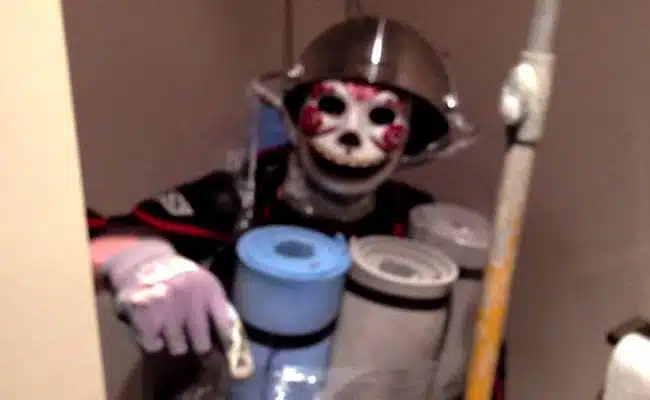
“It’s gonna be the end, this and that, all this nonsense. It’s gonna be the end of cheeseburgers, the end of hotdogs, the end of pizza and Pepsi, you name it.” The young man looks directly into the camera on his computer, notes tacked to the wall and a Season’s Greetings plaque on a shelf behind him. “So,” he goes on, “I’m here with this video to let you guys know five things and reasons that the world will not end. So, starting from the top, zombies are not going to take over the world.”
It’s 25 minutes into Hoax_Canular, a found footage documentary featuring homemade videos about the end of the world. Gleaned from all over YouTube, the clips range from kids in survival gear and earnest singers with guitars to a guy who’s jogging along with an offscreen exercise video so he can “have a six pack when the world ends” to the kid with the awesome afro, patiently explaining just why all those people who believe the world will end on an upcoming date are wrong.
Still, the possibility goads new ways of thinking, new perceptions of identity and communication. “I don’t need an to the frame that all you see are his eyes in blue monitor light, ooky and near at the same time. “And that’s not even a word and I know that, but I say it because the end of the world is in 20 fucking days.”
Dominic Gagnon’s documentary, which screened at the Doc Yard on 3 November and is available on YouTube, structures these self-performances so they tell a story of hope and fear and hope again. Subjects describe their visions of the coming apocalypse, images drawn from video games and monster movies. This whether they reject such “nonsense,” like the kid with the Season’s Greetings plaque, or they embrace them, such as the several young people who advise their viewers on which weapons or gear will best help them survive.
One boy advises a survival kit that’s small enough to carry but big enough to hold everything you’ll need. He holds up his “tiny little turtle backpack”, as well as what he’s putting in it, sleeping pills (“because there’ll be a lot of screaming”), liquor and, he adds, “You’re also going to want a doomsday companion,” at which point he shows off a fluffy white dog he’ll tuck inside. Other self-made experts plan for combat.
“Here are some of the essential tools for you to have,” offers a kid decked out in a helmet and pads. “The bat is an excellent bludgeoning tool, with its long reach, however, this makes it unsuitable for close quarters combat, unlike the hammer with its short reach.” Here he shows each item he describes, framing it closely so he’s reduced to a green-shirted torso or hand. Still, he concludes, “Firearms are the most essential part of your bailout kit,” because, well, because “Nothing is gonna put a zombie down faster.”
Certainly, zombies are easy reference points, conjuring anxiety and horror, and allowing subjects to propose survival tactics everyone already knows or to dismiss the very notion irrational and its adherents idiots and morons (the name-calling here is mostly rudimentary). While such rants are familiar, as they are situated here alongside other rants, as well as other approaches to the world’s end, they become part of an almost profound interplay of stories, not only self-expressions but also self-creations.
Subjects dance and show off their creative costuming and makeup, some endeavor to instruct (“Where has our society gone that we no longer value critical thinking?” laments a young man whose sparse beard is frighteningly close to the camera) or rationalize (“It’s so much better, so much more peaceful, there wouldn’t be depression and shit because everyone would be dead,” says one very pale girl, “I kind of want it to end, I don’t want to die, it’s just if I’m going to, I want everyone else to die with me”).
Several speakers predictably use the coming end — and the camera — to hold forth generally on morality and fate, as well as their own special insight: “Anyone who thinks that this is a hoax, you’re out of your goddamn mind, you have four days to repent for your sins,” grumbles an especially angry white guy, “It will happen, I know, I have evidence: God spoke to me in my dreams.” Some insights are less furious, such as one girl with a Lady Gaga poster on her wall, who laments “conspiracy theories” that “go out and scare people.”
The easiest reading here is that the kids imagine an end of the world where they survive in order not to be scared by the end of the world, or better, not to be scared by the world as it is. But the many iterations suggest other possibilities too, as the performers address listeners they can only imagine. Of the many things the internet can do, its capacity to engender upset and fear, resentment and excitement, its most fundamental function is connecting people.
For all the stories about how isolated and asocial internet users can be, this film offers other stories too; stories of imagining community, sharing truths and fictions and whatever might fall in between.

